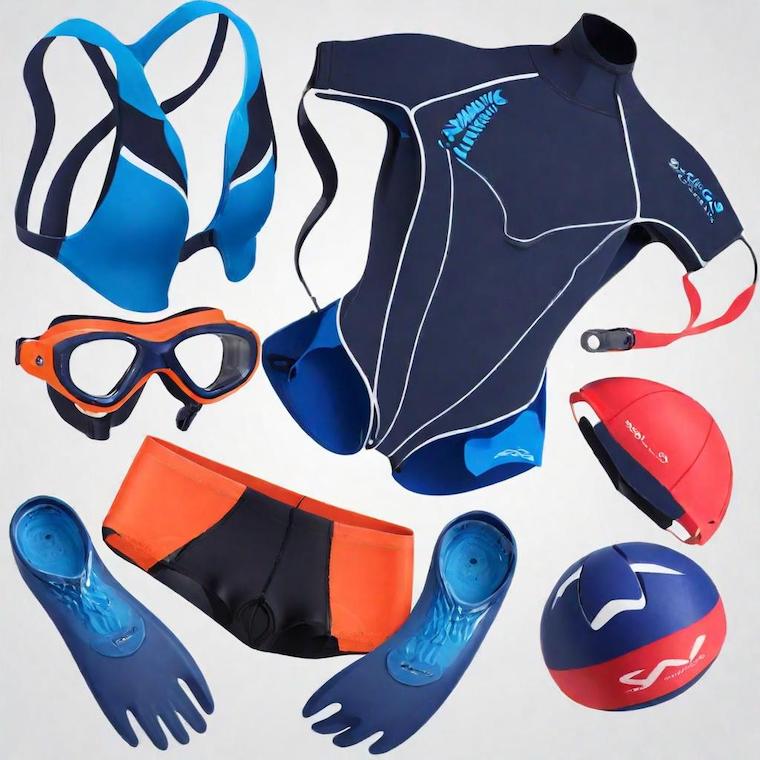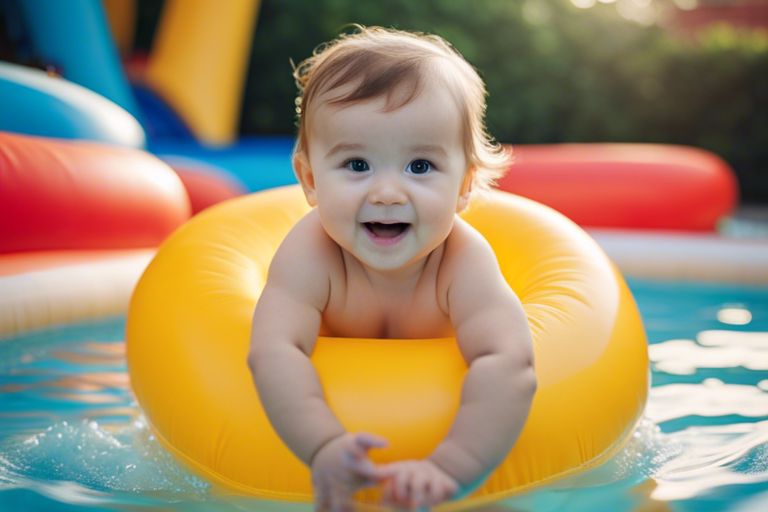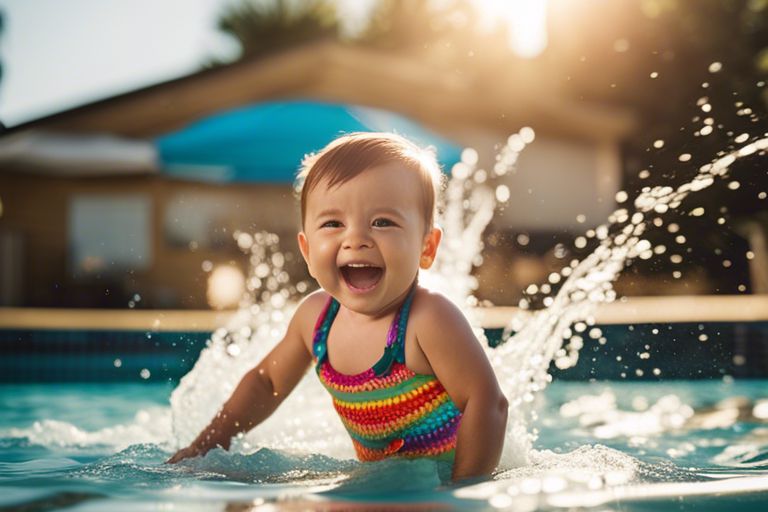Dive into the world of swimming with the right gear! From beginners to seasoned pros, having the right swimming gear is essential for a comfortable and successful swim. Whether you’re aiming for a leisurely dip or competing at the highest level, the right gear can make all the difference. Let’s explore the essential swimming gear—caps, goggles, and swimwear—and how they can enhance your swimming experience, no matter your skill level.
Swimming Caps
Swimming caps are more than just a fashion statement—they serve several important purposes for swimmers of all levels. Here’s why you should consider using a swimming cap and how to choose the right one for you:
- Purpose of Swimming Caps:
- Reducing Drag: Swimming caps are designed to reduce drag in the water, allowing swimmers to move more efficiently through the water.
- Hair Protection: Swimming caps help protect your hair from the damaging effects of chlorine and saltwater. They also keep your hair out of your face while swimming, allowing for better visibility.
- Types of Swimming Caps:
- Silicone Caps: Silicone caps are durable, hypoallergenic, and offer a comfortable fit. They are less likely to snag or pull hair.
- Latex Caps: Latex caps are more affordable but less durable than silicone caps. They are lightweight and provide a snug fit.
- Lycra Caps: Lycra caps are soft and comfortable, but they offer less protection against water and are more prone to slipping.
- Choosing the Right Swimming Cap:
- Material: Consider the material of the cap based on your needs. Silicone caps are more durable, while latex caps are more affordable.
- Size: Choose a swimming cap that fits snugly but not too tight. A cap that is too tight can be uncomfortable and may cause headaches.
- Design: Look for a swimming cap with features that suit your needs, such as a textured interior for better grip or a special shape for improved hydrodynamics.
- Additional Features: Some swimming caps come with added features like UV protection or thermal insulation, which can be beneficial depending on your swimming environment.
Swimming Goggles
Swimming goggles are an essential piece of gear for swimmers of all levels, offering both eye protection and clear vision underwater. Here’s why swimming goggles are important and how to choose the right pair for you:
- Importance of Swimming Goggles:
- Eye Protection: Swimming goggles protect your eyes from irritants in the water, such as chlorine, salt, and debris. They also help prevent eye infections and redness.
- Clear Vision: Goggles provide clear vision underwater, allowing you to see clearly and navigate the pool or open water without straining your eyes.
- Types of Swimming Goggles:
- Recreational Goggles: These goggles are designed for casual swimmers and provide basic eye protection and vision enhancement.
- Competition Goggles: Competition goggles are designed for serious swimmers and offer a sleek, low-profile design for minimal drag in the water.
- Prescription Goggles: Prescription goggles are available for swimmers who need corrective lenses. These goggles are custom-made to your prescription for clear vision underwater.
- Choosing the Right Swimming Goggles:
- Fit: Look for goggles that fit comfortably around your eyes without being too tight. A good seal is essential for preventing water from entering the goggles.
- Lens Type: Choose lenses that suit your swimming environment. Clear lenses are ideal for indoor pools, while tinted or mirrored lenses are better for outdoor swimming in bright conditions.
- Anti-Fog Features: Consider goggles with anti-fog coatings or features to prevent fogging and ensure clear vision throughout your swim.
- Adjustability: Look for goggles with adjustable straps and nose bridges for a custom fit. This will help prevent leaks and discomfort during your swim.
Swimwear
Swimwear plays a crucial role in a swimmer’s comfort, performance, and hydrodynamics. Here’s why choosing the right swimwear is important and how to select the best option for your needs:
- Importance of Swimwear:
- Comfort: Swimwear should fit well and allow for freedom of movement without chafing or discomfort.
- Performance: The right swimwear can improve your hydrodynamics in the water, reducing drag and enhancing your speed.
- Hydrodynamics: Swimwear is designed to reduce resistance in the water, allowing you to move more efficiently and effectively.
- Types of Swimwear:
- Briefs: Briefs are a popular choice for competitive swimmers, offering minimal coverage and maximum freedom of movement.
- Jammers: Jammers are longer than briefs and provide more coverage, making them a great option for swimmers who prefer a more modest look or need extra muscle support.
- Swimsuits: Swimsuits come in various styles, including one-piece and two-piece options, and are suitable for all types of swimmers. They offer good coverage and support for recreational swimmers.
- Choosing the Right Swimwear:
- Material: Look for swimwear made from chlorine-resistant fabric, especially if you swim regularly in pools. This will ensure that your swimwear lasts longer and maintains its shape.
- Fit: Choose swimwear that fits snugly but comfortably. Avoid swimwear that is too tight, as it can restrict movement and cause discomfort.
- Intended Use: Consider the purpose of your swimwear. For training, you may want a durable, performance-focused option, while for leisure swimming, comfort and style may be more important.
- Style: Choose a style that suits your body type and preferences. Whether you prefer a sporty look or a more fashionable design, there are swimwear options to suit every taste.
Additional Gear and Accessories
While swimwear, goggles, and caps are essential, there are other gear and accessories that can enhance your swimming experience. Here are some accessories to consider:
- Earplugs: Earplugs can help prevent water from entering your ears, reducing the risk of ear infections and swimmer’s ear. They are especially useful for swimmers who are prone to ear problems.
- Nose Clips: Nose clips can help prevent water from entering your nose while swimming, reducing the risk of inhaling water and discomfort. They are particularly useful for swimmers who are learning to swim or those who swim in choppy water.
- Swim Fins: Swim fins, also known as flippers, can help improve your swimming technique and build leg strength. They are ideal for training and can help you swim faster and more efficiently.
- Kickboard: A kickboard is a flotation device that swimmers can use to isolate their leg movements and improve their kick technique. It’s a great tool for building leg strength and improving overall swimming performance.
- Pull Buoy: A pull buoy is a flotation device that swimmers can place between their legs to isolate their arm movements. It helps improve upper body strength and technique by focusing on the arms and shoulders.
- Swim Snorkel: A swim snorkel is a device that allows swimmers to breathe easily while keeping their face in the water. It’s useful for improving technique and endurance, as it allows swimmers to focus on their stroke without having to worry about breathing.
- Waterproof Fitness Tracker: A waterproof fitness tracker can help you track your swimming workouts, including distance, pace, and calories burned. It’s a great way to monitor your progress and set goals for your swimming fitness.
- Swim Towel: A quick-drying, absorbent swim towel is essential for drying off after your swim. Look for a towel that is lightweight and compact for easy carrying to and from the pool.
By incorporating these accessories into your swimming routine, you can enhance your comfort, improve your technique, and make the most of your time in the water.
Care and Maintenance of Swimming Gear
Proper care and maintenance of your swimming gear are essential for prolonging its lifespan and ensuring optimal performance. Here are some tips on how to care for and maintain your swimming gear:
- Rinse After Use: After each swim, rinse your swimwear, goggles, and caps in fresh water to remove chlorine, salt, and other chemicals. This will help prevent damage and discoloration.
- Hand Wash: Hand wash your swimwear in mild detergent and cool water. Avoid using harsh chemicals or bleach, as they can damage the fabric. Gently squeeze out excess water and lay flat to dry.
- Avoid Sun Exposure: Direct sunlight can cause your swimwear to fade and deteriorate. Avoid leaving your swimwear out in the sun for extended periods and instead, dry it in the shade.
- Store Properly: Store your swimwear, goggles, and caps in a cool, dry place away from direct sunlight and heat. Avoid folding or creasing them, as this can cause damage to the fabric.
- Clean Goggles Lenses: Clean your goggle lenses with a soft cloth or lens cleaner to remove dirt, debris, and fog. Avoid using abrasive materials that can scratch the lenses.
- Check for Damage: Regularly inspect your swimwear, goggles, and caps for any signs of damage, such as tears, loose straps, or worn-out elastic. Replace any damaged gear to ensure your safety and comfort in the water.
- Use a Mesh Bag: Consider using a mesh bag to store your swimming gear. This allows air to circulate, helping to prevent mold and mildew growth.
- Rotate Your Gear: If you swim regularly, consider rotating between multiple pairs of goggles and swimwear. This can help prolong the lifespan of your gear by reducing wear and tear.
Conclusion
In conclusion, choosing the right swimming gear is essential for a comfortable, safe, and enjoyable swimming experience. Swim caps, goggles, and swimwear all play a crucial role in enhancing your performance and protecting you in the water.
Swim caps reduce drag and keep your hair out of your face, goggles protect your eyes and improve visibility underwater, and swimwear provides comfort, performance, and hydrodynamics. Additionally, accessories like earplugs, nose clips, and swim fins can further enhance your swimming experience.
To make the most of your time in the water, invest in quality swimming gear that fits well and suits your needs. Proper care and maintenance of your gear will prolong its lifespan and ensure optimal performance.
So, whether you’re a beginner or a seasoned swimmer, investing in quality swimming gear can help you swim more comfortably, perform better, and enjoy your time in the water to the fullest.



